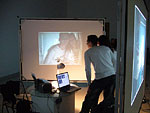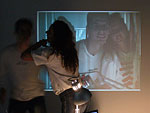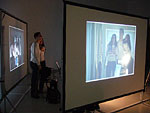MEDIA ART 2005
Zsolt Mesterházy /
Roland Pereszlényi
Péter Forgács
Éva Kozma /
Szabolcs Géza Veres
Róbert Langh
Ádám Lendvai
Jenő Lévay
Erik Mátrai
Nextlab
Antal Örkényi
András Ravasz
János Sugár
Pál Szacsva y
Zoltán Szegedy-Maszák /
Márton Fernezelyi
András Szőnyi
Szilvi Tóth /
Gáspár Benedek
Júlia Vécsei
Harmonográf
interactive installation
In the course of producing each harmonogram (exposure), the camera records the image made up of the points along the vertical lines that succeed one another. The processes occurring in front of the machine, the starting and finishing points in time of the operations to be performed, appear in a single figure. The method of exposure resembles that of the slit camera. It is always only a vertical line of the view that is registered at a time. Progressing from right to left along this narrow band, the image is drawn onto the three screens – within thirty seconds. (The time of this mode of exposure does not resemble that of the long exposure of traditional photography, but should rather be imagined as a sequence of extremely brief exposures, taking place over the course of thirty seconds.) The most unusual feature of the harmonograph is that it is capable of drawing the mirror image as it appears in time, if in the course of preparing the harmonogram, the movement of the motif is of variable velocity relative to the speed of the line of sensation (it lags behind the exposure time, or it overtakes it).
The line of detection is indicated by a thin, red band on the screens. From among the three harmonograms appearing on the laptop monitor, one may be printed by double-clicking on the image. The process can be restarted by clicking on the start button of the laptop. Until the next exposure, the previous harmonograms are visible on the screens.
 |
 |
 |
 |
 |
 |